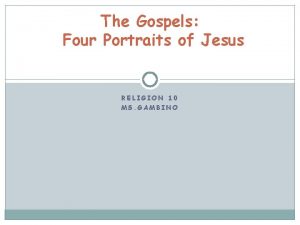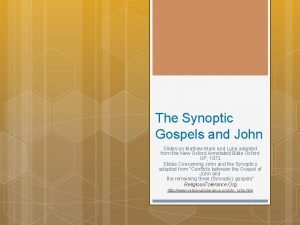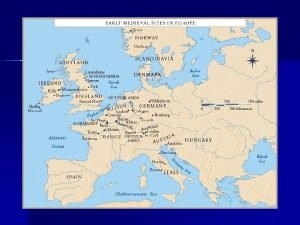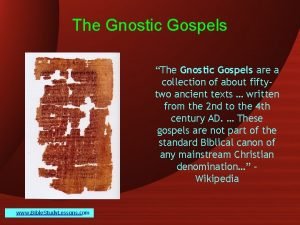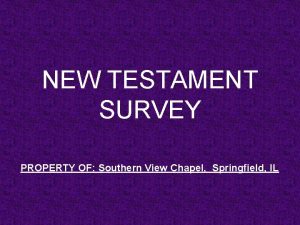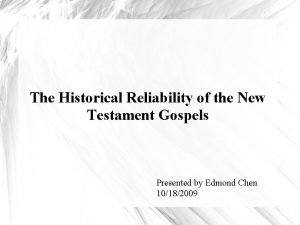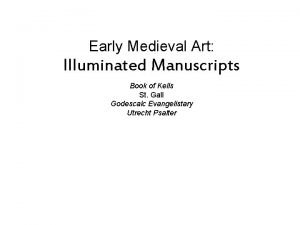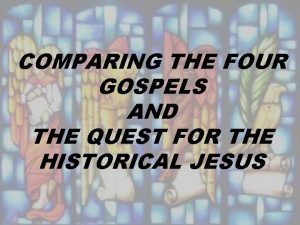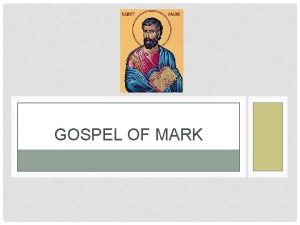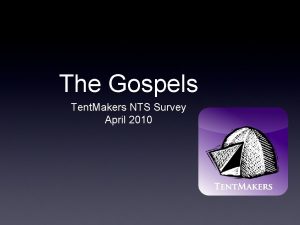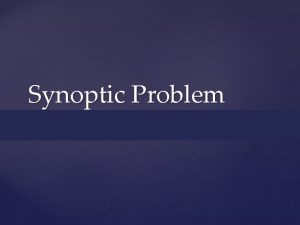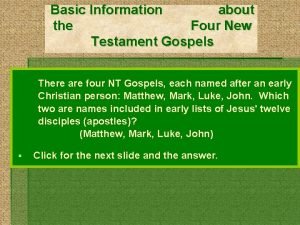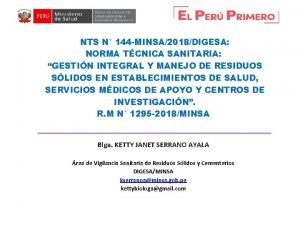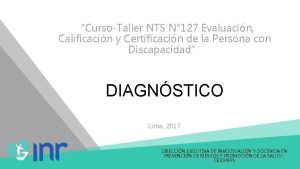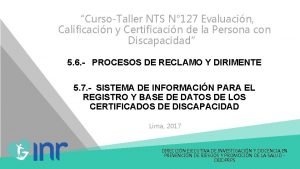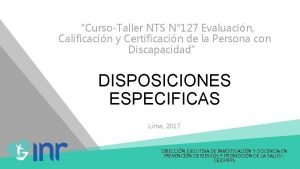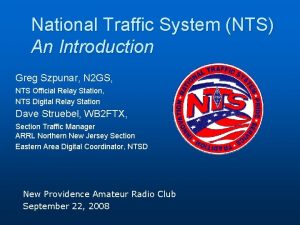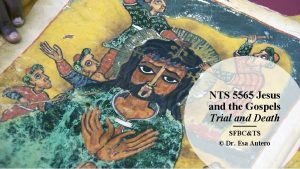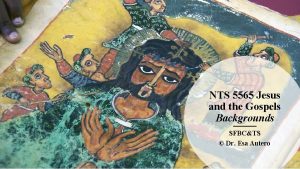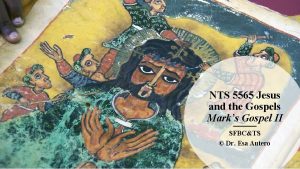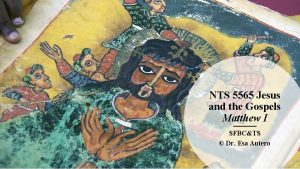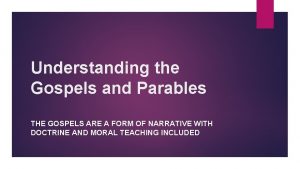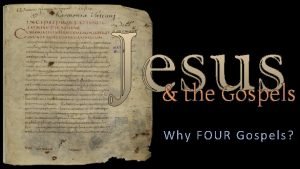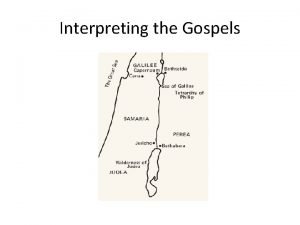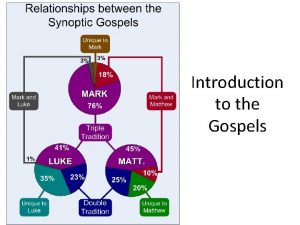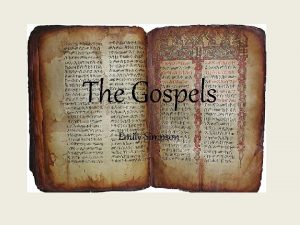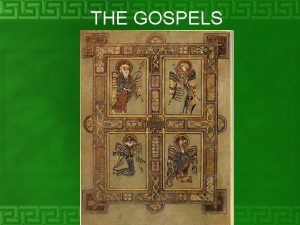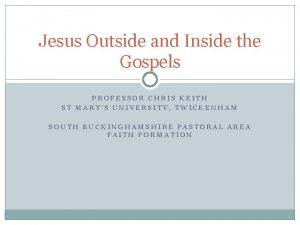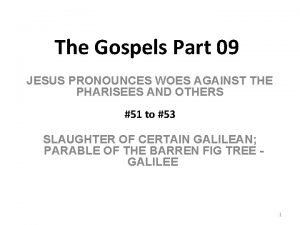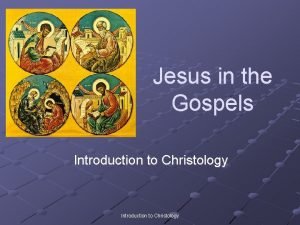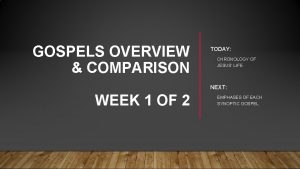NTS 5565 Jesus and the Gospels Jesus and






















- Slides: 22

NTS 5565 Jesus and the Gospels – Jesus and History I: Birth and Infancy SFBC&TS © Dr. Esa Autero

Jesus and the Gospels 1. 1 Introduction to Historical Jesus Research • Christian interpreters & their critics • Justin Martyr, Origen, Augustine – Trypho, Celsus, Pelagius • Enlightenment & Modern gospel study in 18 th century • Enlightenment – a new way of thinking and seeing the world • The rise of historical criticism – presuppositions • • The church has misinterpreted the Bible Jesus not divine Miracles of Jesus – results of outdated worldview Bible is like any other religious book and should be studied as such Jesus of history and Christ of faith separated (cf. Matt 26: 11; 28: 20) What can be known about Jesus according to historical research? Historical–critical approach the only legitimate method Old dogmas of the church rejected or radically criticized

Jesus and the Gospels The “Quests” for historical Jesus • The First Quest (1778 -1906) • H. S Reimarus (1778) • D. F Strauss (1835) • A. Schweitzer – The Quest for Historical Jesus (1906) • • Separation of historical Jesus & Christ of faith Christianity stood in contradistinction to historical Jesus Miracles made more “palatable” Jesus made into the “image” of the questers • Abandoned Quest (1906 -1953) • Nothing can be known of the “true” Jesus – or it is irrelevant • R. Bultmann and demythologizing project

Jesus and the Gospels • The New Quest (1954 -) • E. Käsemann “The Question of the Historical Jesus (1953) • Gospels as “theological fiction” • The question and use of sources (GTh; GHb; GPet) • The Jesus Seminar as epitome of skepticism w/ anti-Christian presuppositions • The Third Quest (1965 -) • G. B. Caird Jesus and the Jewish Nation (1965) • Emphasis on Jesus’ Jewishness • Research w/o presuppositions is impossible Recent pictures of Jesus – from Jewish sage/miracle worker to Hellenistic cynic philosopher to feminist/social revolutionary

Jesus and the Gospels 1. 2 Criteria for Evaluation Authenticity – Jesus’ words & deeds • Historical research plausible – probable – possible • Multiple attestation • Tradition appears in multiple sources – more likely authentic • Multiple forms • Topic embedded in saying and narrative – more likely authentic • Dissimilarity [or double-dissimilarity – explains continuity] • No parallels in Judaism or Early Christianity – more likely authentic • Problem: was Jesus more like a Greek philosopher? • Simplest form of tradition • Tendencies for embellishments – See E. P. Sanders’ (1969) critique

Jesus and the Gospels • Embarrassment • A saying that seems embarrassing (e. g. Peter’s denial) • Disagreement with the tendencies of the evangelist • E. g. a saying that praises rich in Luke • Anachronism • Irrelevant in the Palestinian setting Mark 10: 11 -12 [woman initiating divorce] • Coherence • Tradition that coheres with other authentic traditions • Memorable form or content (humorous, surprising) • Difficult to evaluate

Jesus and the Gospels • Criteria based on Enlightenment skepticism and philosophical presupposition of naturalism (Troeltsch’s [1898] criticism, analogy, correlation) Burden of proof immense – reconstructions of Historical Jesus vary • Further philosophical and critical questions • Which criteria to give priority? Why? • Coherence supports prior reconstruction • Other criteria for authenticity – e. g. archaeology?

Jesus and the Gospels 1. 3 Agree-upon Critical “Findings” about Jesus – even by skeptical scholars • Jesus came from Nazareth • Jesus began his public life as a disciple of John the Baptist • Jesus was a teacher and healer/exorcist • Jesus had followers – 12 of inner circle • Jesus focused his mission on Israel • Jesus preached the Kingdom of God • Jesus clashed with Jerusalem authorities about the Temple • Jesus was crucified as Messianic pretender by Pilate • Jesus’ followers believed they encountered him after death • Jesus’ followers formed a movement awaiting his return and winning new converts

Based on “criteria for authenticity” – little may be confirmed of the historicity of Jesus’ birth Jesus and the Gospels 2. 1 Jesus’ Birth and Infancy – Historical perspective • Found in two separate and independent traditions – Matt 1 -2 & Luke 1 -2 • Later apocryphal gospels invented further stories to fill in gaps • Protevangelium of James; Infancy gospels of Thomas; Arabic Infancy Gospel legendary – don’t contribute historical material* • Matthew’s birth narrative storyline summarized Does Matthew presuppose • Focus on Joseph – five formula quotations from OT that J&M live in Nazareth How old is • Genealogy and Jesus’ birth announced (1: 1 -25) or Bethlehem? (cf. 2: 1; Jesus when • Angel appears to Joseph – Mary is pregnant by the HS 2: 22 -23) Magi visit? • Jesus born in Bethlehem – Magi to Jerusalem, then to Bethlehem (2: 1 -12) When to • Magi return, Herod furious, holy family to Egypt & massacre (2: 12 -18) Egypt and • Herod dies, holy family returns – to Nazareth (2: 19 -23) how long?

Jesus and the Gospels How do Magi’s • Luke’s storyline in summarized • Focus on Mary – OT fulfilled by use of allusions (and some quotes) visit and flight to Egypt fit in? • Birth of John the Baptist to Zechariah and Elizabeth (1: 5 -24) • Angel announces the future birth of Jesus – and virginal conception to • • • Mary (1: 25 -38) – family in Nazareth Mary’s visit to Elizabeth in Judean hill country + Magnificat (1: 39 -56) Birth of John and Benedictus (1: 57 -80) Birth of Jesus – Roman census during Quirinius’ governorship of Syria; Joseph & Mary go to Bethlehem to be registered and Jesus born (2: 1 -7) Angels appear to the shepherds who see Jesus and rejoice (2: 8 -20) Holy family to Jerusalem at the time of “purification” and Simon’s Nunc Dimittis and Anna’s prophecy over Jesus (2: 21 -38) Return to Galilee (2: 39 -40) and boy Jesus in Temple (2: 41 -52)

Jesus and the Gospels • Differing and similar elements in the storylines – a summary • Matthew: focus on Joseph • Star, Magi, Herod’s plot to kill, slaughter on children, flight to Egypt • Luke: Focus on Mary • Zechariah & Elizabeth, birth of John, census that brings Mary & Joseph to Bethlehem, visit of shepherds, baby Jesus presented in the Temple, hymns of Benedictus, Magnificat, and Nunc Dimittis How reconcile the differences? Possible to harmonize accounts? • Agreed upon points • Jesus born in Bethlehem, virginal conception, Joseph and Mary, descendant of David and Messiah, fulfillment of OT expectations, birth in Bethlehem and return to Nazareth …

Jesus and the Gospels 2. 2 Difficult sections of Infancy and Birth Narratives – w/ some solutions • Most difficult sections: • Differences in the genealogies of Matt & Luke • Differences in chronology or narrative accounts (esp. flight to Egypt) • Date of Jesus’ birth • Census of Quirinius and difficulties surrounding it • Differences in genealogies**: • Matt’s and Luke’s genealogies differ significantly • Note esp. grandfather of Jesus – (H)eli (Luke 3: 23) or Jacob (Matt 1: 16)? * • Joseph’s father’s name either Heli or Jacob

Jesus and the Gospels • Other similarities and differences* • Matthew – from oldest to youngest; Luke vice versa • Matthew starts w/ Abraham, Luke with Adam • Matthew stops to explain significance of some names (e. g. Babylon Exile; certain names highlighted or explained) • Matt: 3 groups of 14 according to gematria based on David’s name – Luke includes 11 groups of 7 w/ no apparent reason • Matthew lists women, Luke only men (despite Luke’s focus on women) • In section from Abraham to Jesus, Matt includes 41 names whereas Luke has 57 names • From David to Jesus – only names 2 overlap: Shealtiel and Zerubbabel How to account for the differences?

Matt 1: 15 -16 Luke 3: 23 -24 Eleazer Levi Jesus and the Gospels Matthan Jacob Joseph • Some commonly attempted solutions* • i) Impossible to find a solution for genealogy dilemma – only source for genealogies is OT precedents in Gen and 1 Chr – used theologically to highlight Jesus’ Messiahship and royal descend • ii) Matthew’s genealogy through Joseph and Luke’s through Mary – Joseph is Luke (3: 23) only “supposed [assumed] to be” – yet Mary not named in Luke’s genealogy but Joseph is not likely option • iii) Luke gives the physical descend – Matthew royal descend (or vice versa) OR Luke gives legal descend and Matthew physical descend --most difficult part is to figure the relationship between Jacob and Heli Matthat Heli Joseph If there’s no sons • Same person with two different names? But different names for father (or son dies), a • Are Matthan and Matthat same/different person? – what about their fathers? daughter bears the • Were Jacob and Heli brothers, half-brothers – connected through Levirate family line marriage, adoption or other means(? )

Matthew’s genealogy = through. Talmud refers to Mary’s father as Eli Solomon indicates royal line – (y. Sanh. 23 c; y. Hag 77 d) and Protev. Luke’s genealogy includes mostly. Jam. 15 -17 as Joachim which is a Hb. variation of Eliakim (akin to Heli)* unknown names* Matt 1: 15 -16 Luke 3: 23 -24 Eleazer Levi Jesus and the Gospels Matthan Matthat Jacob Joseph • A possible though unproven solution • Mary is an heir of Heli since she had no brothers. Heli adopted Joseph as Heli Joseph son on their marriage (like in Ezra 2: 61; Neh 7: 63; Num 27: 1 -11; 1 Chr 2: 34 -35) – Luke’s genealogy reflects legal, not physical line • Whichever view – Jacob and Heli must have had a close relationship as brothers, half-brothers, through marriage of Heli’s sister to Jacob, levirate marriage or adoption Main point: Jesus can claim the throne through David and is related to all humanity through descend through Adam (and brings about new creation) • Other issues in genealogies • Names commonly omitted in genealogies – “begetting” = be ancestor of… • Differing names reflect physical and/or legal/royal descend • Jews kept genealogies meticulously – not likely created/invented

Jesus and the Gospels • Harmonization of events – esp. flight o Egypt • How to harmonize baby Jesus’ flight to Egypt (Matt 2: 13 -16) with Luke’s presentation of baby Jesus at the Temple in Jerusalem (Luke 2: 21 -25)? • Flight from Bethlehem to Egypt and back would have taken a several months or perhaps up to two years – then return to Nazareth (2: 22 -23) • Jesus presented at Jerusalem Temple 5 -6 wks after birth (Lev 12: 1 -5) after presentation “they returned to…Nazareth” (2: 39) • Very few chronological markers given – ancient biographies skipped everything else except that which was relevant for the author • Both Matt&Lk indicate birth of Jesus in Bethlehem – and original home in Nazareth (cf. 2: 22 -23) • Matt implies that family wanted to reside in Bethlehem (Matt 2: 22 -23)

Jesus and the Gospels • Virginal conception – shame and reputation ruin in small town (Nazareth) • Possible way to reconcile accounts – after the birth, holy family goes to Jerusalem and then come back to Bethlehem (not mentioned by Luke) where Magi find them • Flight to Egypt occurs after the visit of Magi and Herod’s fury – then they finally settle in Nazareth The harmonization is possible though both accounts should be read as independent stories first before attempts to find historical solutions to differences

Jesus and the Gospels • Date of Jesus’ birth* • Jesus’ birth occurred b/f the death of Herod the Great (Matt 2: 1/Luke 1: 5) • According to Josephus, an eclipse just b/f Herod’s death (Ant. 17. 167) Eclipse March 12/13, 4 BC – only one mentioned by Josephus • Passover just after Herod’s death – that is, beginning of April 11 th, 4 BC Herod’s death b/w March 12/13 and April 11 th, 4 BC and Jesus’ birth prior to Herod’s death by March/April 4 BC – most likely a bit earlier, such as 6/7 BC • Date of Jesus’ birth traditionally – in West Dec 25 th, East Jan 6 th • Evidence from Church Fathers mixed to confirm either date • Shepherds grazed sheep outside year round (m. Seq. 7. 4; cf. Luke 2: 8)

Jesus and the Gospels • Census of Quirinius and related events* • Problem stated: • i) No known empire wide census during the time of Augustus • ii) No Roman census required Joseph to return to Bethlehem & no census during the time of Herod the Great in Palestine • iii) Census of Quirinius dated to AD 6 not to Jesus’ birth around 4 -7 BC (Ant. 17. 13. 2; 17. 13. 5; 18. 1. 1) • iv) Quirinius was not a governor at the time of Jesus’ birth – governors’ records are well known (Tacitus, Ann. 3. 48; Ant. 17. 13. 5) Luke has invented and/or mistakenly recorded events at Jesus’ birth(? )

Jesus and the Gospels • Luke’s record is not one in AD 6* – Herod the Great dead by then • Birth of Jesus and census must be c. AD 4 or so • Could there have been a census during Herod the Great’s reign, tied to Quirinius – as Luke seems to claim? • Augustus instituted 3 census at the time – local census known from Egypt (every 14 yrs. since 10 -9 BC) and Syria, Gaul & Spain Rome active in register people, citizens and foreigners • Luke’s “empire-wide” census probably reference to an on-going practice of the time that now had a local Palestine based focus • Joseph’s return to “hometown” – explainable by the fact that Rome often allowed local customs to prevail, thus in Israel return to hometown (not ancestral city of origins per se) Details, properly interpreted, fit into Roman taxation policies

Jesus and the Gospels • What about the rulership and role of Quirinius? • Attempted to solutions – lexical, historical, interpretative • Quirinius governor twice – once in AD 6 and earlier during Jesus’ birth some (slim) evidence point to this direction though very inconclusive • Governorship gap exists in Roman records for 4 BC-1 BC – this could be the time of Quirinius possible though still not during the time of Herod the Great Census could have been initially started by earlier governor (Varus) and then Quirinius completed it – good suggestion – census would take a long time and overlapping administrations probable at least occasionally Quirinius not governor/legate but an administrator of census, initiated c. 6 BC and ran from the time of Saturninus to Varus

Jesus and the Gospels αὕτη ἀπογραφὴ πρώτη ἐγένετο ἡγεμονεύοντος τῆς • Solutions based on semantic range (lexical solutions) Συρίας Κυρηνίου. (Luke 2: 2) of • Quirinius separated from census in 2: 2 by way of ellipse – the meaning Gr. πρώτη should be translated as “earlier”, not “first” (cf. John 1: 15, 30) Luke thus says that this census was one earlier than the well-known census led by Quirinius in AD 6 As above but πρώτη should be translated as “before”, not “first” (cf. John 15: 18) – census then took place before Quirinius’ governorship Both above possible though not typical usage of the word No perfect solutions available at the moment – lexical solutions good and possible – and also the overlapping of governorships • Luke reliable in many other details – confidence for this as well
 4 portraits of jesus
4 portraits of jesus The date
The date Who commissioned the gero crucifix
Who commissioned the gero crucifix Gnostic gospels summary
Gnostic gospels summary Bema judgement meaning
Bema judgement meaning The virgins memo genius
The virgins memo genius Reliability of new testament
Reliability of new testament Ebbo gospels
Ebbo gospels Comparing the four gospels
Comparing the four gospels Synoptic gospels
Synoptic gospels List the synoptic gospels
List the synoptic gospels Sunoptic gospels
Sunoptic gospels Gospels
Gospels Sunoptic gospels
Sunoptic gospels Four new testament gospels
Four new testament gospels Is the triumphal entry in all four gospels
Is the triumphal entry in all four gospels Jesus is the sweetest name i know
Jesus is the sweetest name i know Jesus in the morning
Jesus in the morning Ntp 144
Ntp 144 Nts 127
Nts 127 Nts 127
Nts 127 Nts 127
Nts 127 Nts
Nts
